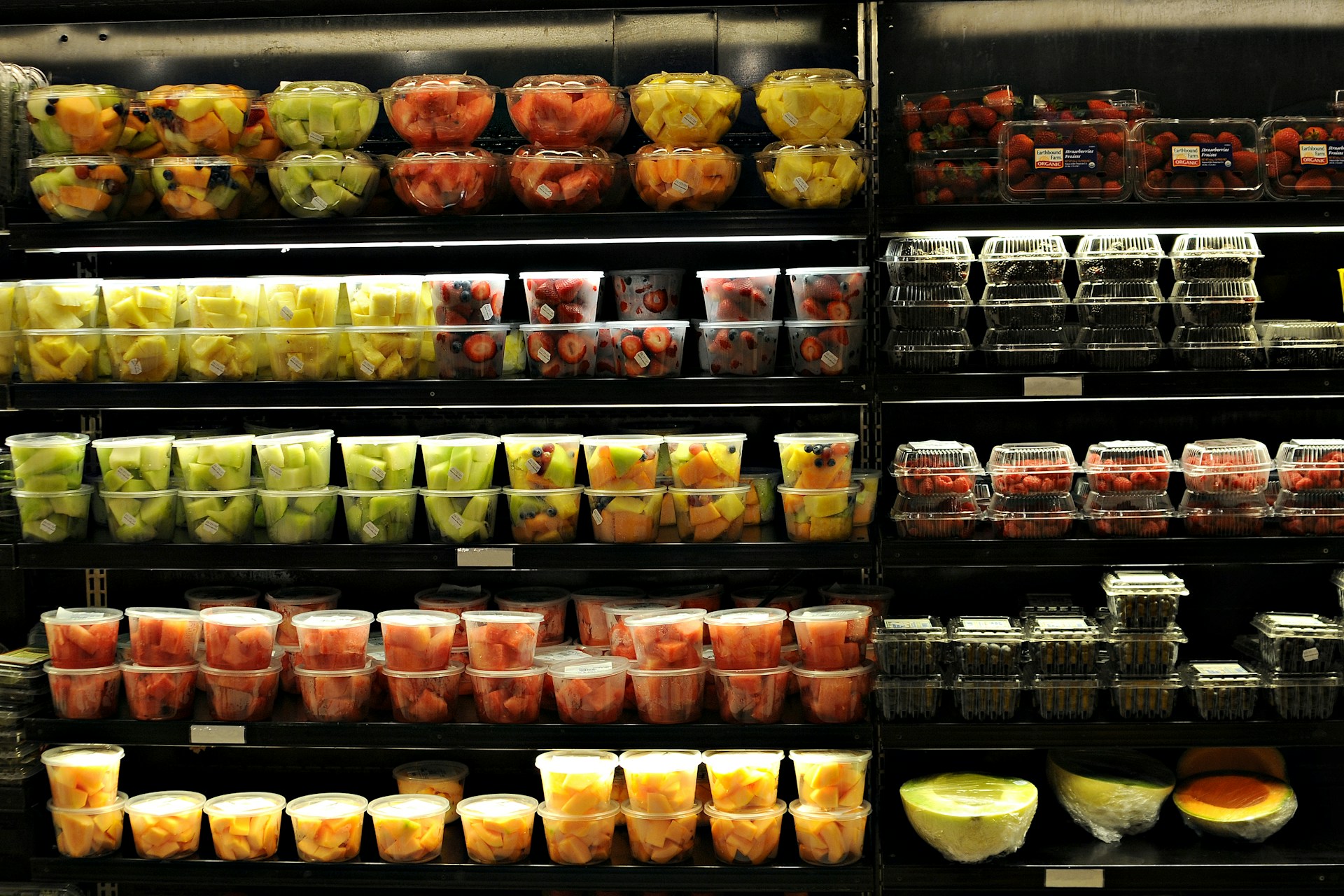The dynamic nature of the processed produce sector presents an ongoing challenge for contemporary businesses.
Consequently, achieving an expanded market share requires a strategic mix of astute planning, actionable insights, and market-reactive adaptations.
The realm of processed foods is continually evolving, demanding a degree of expertise and inventive strategies for securing growth.
This article sheds light on effective strategies for fortifying your business prominence within this competitive industry landscape.
It delves not only into the nuanced facets of the market but also intricacies specific to the processed produce sector.
The primary focus here is to provide a pragmatic approach to expanding a company’s market reach, robustly and sustainably.
Contents
- Strategies For Expanding Your Processed Produce Market Share
- 1. Improve product quality and freshness.
- 2. Develop Unique, Innovative Packaging
- 3. Increase distribution channels.
- 4. Offer Competitive Pricing Strategies
- 5. Implement strong advertising and promotion.
- 6. Develop Partnerships with Retailers
- 7. Offer Variety of Processed Produce Options
- 8. Invest in Effective Branding
- 9. Involve customer feedback in product improvement
- 10. Ensure consistent supply of products.
- The Bottom Line
1. Improve product quality and freshness.
When it comes to discussing strategies for expanding your processed produce market share, the first item to consider is enhancing product quality and freshness.
For many customers, the quality and freshness of the product they purchase is of utmost importance, making it a key determining factor when choosing among competitors.
High quality, fresh processed produce not only attracts customers but also builds trust in your brand.
Remember, satisfied customers are more likely to repeat purchases and recommend your brand to others, which thereby elevates your market share.
Thus, investing in quality improvement measures and modern refrigeration or preserving techniques to maintain freshness is a profitable strategic step forward.
On the other hand, delivering lower quality or less fresh produce can heavily displeasure your customers, negatively affect your brand reputation, and ultimately lower market shares.
Quality control systems should be put in place to monitor the entire supply chain process and mitigate any risks that could compromise the quality and freshness of your products.
Regular audits and quality checks in all stages of production, ranging from sourcing the raw produce to packaging and distribution, can immensely help in maintaining quality.
A robust quality control system helps to identify potential pitfalls and areas of improvement, ensuring that the final product delivered to customers meets their expectations in terms of quality and freshness.
Engaging the services of an external certain agency can provide an unbiased view on quality and further enhance consumer confidence.
Furthermore, maintaining freshness in processed produce also involves efficient handling and timely delivery.
Implementing a first-in-first-out (FIFO) inventory management system can help to ensure that older stock is sold first, thereby maintaining the freshness of your products.
Another important aspect to consider is the packaging.
Effective packaging is not only visually appealing but also plays a vital role in preserving the freshness of the product.
Innovative packaging technologies such as modified atmosphere packaging can help to extend the shelf life of processed produce.
Therefore, continually striving to improve product quality and freshness can set your brand apart and pave the way for expanding your market share in the competitive processed produce industry.
2. Develop Unique, Innovative Packaging
The importance of unique and innovative packaging in the processed produce market cannot be overemphasiszed. Effective packaging creates an avenue for the product to stand out among competitors and can serve as a compelling marketing tool.
The primary goal of product packaging is to attract the customer’s attention and inspire them to pick the product off the shelf instead of competitors’. An appealing design can be a determinant of whether the product will be purchased or ignored. Therefore, to expand your processed produce market share, innovative packaging is paramount.
Creativity in packaging design cannot be understated. Unique shapes, colors, and textures can set the product apart from the rest, making it more appealing to the prospective buyer.
It’s essential to consider materials that are biodegradable and eco-friendly for packaging. By using such materials, a business not only maintains ethical practices but also keeps the business attractive to environmentally conscious consumers.
Moreover, the packaging should entail clear labeling highlighting the essential information about the product, such as ingredients, nutritional facts, and storage instructions. Clear labeling helps gain the trust of consumers by providing them with transparency about what they are consuming.
To survive in the competitive processed produce market, a business needs to adapt to emerging packaging trends. For instance, adopting interactive packaging such as QR codes can provide customers with more in-depth information about the product, its origins, and even offer recipes or usage instructions. This type of packaging can enhance customer engagement and trust in the brand.
Moreover, consumers demand convenience in their packaging. Packaging solutions such as easy-to-open, resealable, and portion-controlled packaging can help meet the demands of these convenience-seeking consumers.
Remember, maintaining product freshness and quality is a key aim of packaging. Therefore, in the processed produce market, tamper-evident and hermetic seal technology might be crucial in maintaining product freshness while assuring consumers of their safety.
Companies can also use innovative packaging to express their brand identity. For instance, the packaging color, shape, and design can all reflect the brand’s personality and values. Thus, consumers often associate a product with its packaging, making it an essential part of corporate branding.
In line with branding, incorporating a company’s logo prominently in the packaging design can also boost the product’s visibility and recognition in the market.
While innovation is critical in packaging design, it’s important to ensure that the packaging is cost-effective. Producing a unique and appealing package should aim at increasing overall profit margins by luring more customers, rather than increasing the cost of producuction.
Finally, reassessing and refining packaging periodically is a good practice. Consumer trends change at a swift pace and businesses need to keep up by updating their packaging styles and designs as needed.
Overall, developing unique, innovative packaging is not just about making a product look appealing. It’s about communicating the value of the product to the consumer, protecting the product, your brand’s story, and providing convenience to the customers.
With the right innovative packaging, your processed produce business can propel itself into the market and expand its market share.
3. Increase distribution channels.
Expanding distribution channels is a crucial strategy for growing your processed produce market share.
There are several ways to go about this, with each offering unique advantages depending on your business specifics and the market you operate in.
Indeed, creating opportunities in new markets can have an immediate and significant impact on your market share.
One effective method is to tap into online sales, either by selling directly from your company’s website or through an online retailer.
E-commerce has been growing briskly for years, and it may allow you to reach consumers far outside your traditional geographic distribution area.
Another strategy is to increase the presence in brick-and-mortar stores.
This might involve penetrating more grocery stores, convenience stores, and similar outlets in your current regions or branching out into new geographic markets.
Working with distributors who already serve these markets can give your products a welcome boost in visibility.
For this reason, the relationships with your distributors are fundamental, as you will rely on them to promote your product effectively to the retailer and, by extension, the consumer.
Increasing distribution channels shouldn’t mean just adding more places where your product can be bought—it’s about building relationships with them and optimizing placement within them.
Identify the best-positioned channels in terms of sales and growth potential, and invest your resources accordingly.
Ideally, you should also diversify your channel mix to reach as wide an audience as possible.
A channel might be a supermarket chain or a local farmer’s market, but it could also be a school, hospital, or corporate canteen—depending on your product range.
Don’t forget international expansion, if not already explored, this can be an opportunity for growth.
Of course, expanding internationally can be complex, but the potential rewards are significant.
Lastly, always maintain a keen eye on the performance of each distribution channel, leveraging analytics to make data-driven decisions and adjustments.
4. Offer Competitive Pricing Strategies
Successful market expansion in the processed produce industry requires a competitive pricing strategy.
It is vital to understand that the price point significantly influences customer buying behavior.
Therefore, a well-thought-out pricing strategy not only helps in capturing a larger market share but also in enhancing a brand’s reputation and customer loyalty.
A competitive pricing strategy depends on several factors such as production cost, competitor’s price, market demand, and product uniqueness.
To establish a competitive pricing strategy, it is critical to conduct thorough market research that includes monitoring competitors, understanding customer preferences, and analyzing market trends.
Competitive pricing strategies establish the groundwork for market dominance in the processed produce industry.
Moreover, adopting dynamic pricing could be beneficial since it allows a business to adjust the prices based on market changes.
Implementing discounts and offers can also be an effective approach to attract new customers and retain existing ones.
However, it’s important to ensure that discounts do not significantly affect the overall profit margins.
Furthermore, psychological pricing, which involves setting prices slightly lower than a round number (like $9.99 instead of $10.00), has been proven to persuade customers to make a purchase.
Another vital aspect in pricing is to convey the product’s value clearly, affirming that customers are getting quality products at a reasonable price.
Packaging can come into play here as thoughtfully designed packaging can justify the price for processed produce.
Lastly, remember that while competitive pricing can attract customers, maintaining high product quality is also essential to keep these customers.
Simultaneously, constantly revising and adjusting the pricing strategy based on feedback and changing market dynamics keeps a brand relevant and competitive in the market.
This holistic approach to pricing will aid in expanding your market share in the processed produce industry.
5. Implement strong advertising and promotion.
As a company looking to expand its market share in the processed produce industry, it is vital to implement a strong advertising and promotion strategy.
This involves understanding the target audience and creating messages that connect with their needs and preferences.
It might include traditional media channels like TV and newspaper advertising, as well as digital channels such as social media and email marketing.
Companies that employ a comprehensive, multi-channel advertising and promotion approach tend to experience higher interest and conversion rates from potential customers.
Effective advertising strategies are often based on customer insights and data, allowing companies to personalize messages and offers.
To maximize impact, these advertisements should highlight the unique benefits of the processed produce, such as their convenience or nutritional value.
Sales promotions, such as discounts and special offers, can also be an effective method for attracting new customers and encouraging repeat purchases.
Similarly, loyalty programs can incentivize consumers to continue choosing your processed produce, thereby enhancing customer retention and profitability.
In addition, joining forces with other brands for co-promotion can be a win-win situation, as it helps both brands to reach wider audiences.
A good relationship with retail partners can also increase the effectiveness of in-store promotions, thereby helping you to gain visibility and secure more shelf space.
Affiliate marketing, where other companies or individuals promote your products in exchange for a commission, is another potential strategy for boosting visibility and sales.
PR activities, such as press releases and product launches, can generate buzz and improve your brand image in the eyes of consumers and industry stakeholders.
Finally, monitoring the success of your advertising and promotion efforts and adapting your strategies accordingly is essential for long-term success.
By implementing a robust advertising and promotion strategy, you will not only increase your market share in the processed produce industry, but also strengthen your brand and differentiate your products from competitors.
6. Develop Partnerships with Retailers
In order to expand your processed produce market share, building and nurturing strategic relationships with retailers is an essential strategy.
Not only does this help in increasing distribution channels, but also in positioning and branding your processed produce.
Successful partnerships can lead to increased visibility, better shelf-placements, and promotional opportunities.
Engaging with retailers and understanding their needs can help in developing products that cater to specific market segments.
This could involve product size, packaging and unique features that retailers might require for their customer base.
Forming long-term partnerships also ensures a consistent demand for your products, thereby offering more stability for your business.
Building a positive reputation among retailers also opens the door for introductions and partnerships with additional or larger retailers.
In addition to general retailers, consider developing partnerships with specialty stores, organic markets, or health food stores.
These types of retailers might provide a niche market for your processed produce products.
Effective communication, reliability, flexibility and understanding their business objectives is key to fostering strong relationships with retailers.
Considering the margin expectations and sales targets of the retailers during pricing negotiations will win their trust and encourage them to promote your product over competitors.
Also, consider offering promotional materials and support, such as product samples, display units or marketing collaterals.
This can incentivize the retailers to give your products more prominence in the store.
Remember that building and maintaining these retail partnerships require time and effort, but the rewards in terms of increased market share can be substantial.
So, invest time, strategize well, and aim to build these relations for the long haul.
Finally, keep the lines of communication open and try to regularly meet in person with your retail partners to discuss and assess the performance and strategies for future growth.
7. Offer Variety of Processed Produce Options
Expanding your processed produce market share involves a variety of strategies, and offering diverse product options is one of the key tactics.
Meeting diverse consumer tastes and preferences necessitates a broad range of processed produce options.
Offering various product forms such as canned, dried, or frozen fruits and vegetables caters to different consumer consumption preferences.
For example, some customers prefer canned tomatoes for their pasta sauces while others may choose dried mushrooms for their stir-fry dishes.
Developing and offering a variety of produce options also helps to broaden your customer base where different demographic segments with distinct preferences come into play.
Creating diverse product lines tailored to various customer preferences presents an opportunity to capture a larger market share.
There’s potential for market expansion in exploring more unique product offerings such as processed organic produce or ‘ready-to-eat’ options.
Processed organic produce can cater to the growing market segment that values eco-friendliness and healthier food options.
‘Ready-to-eat’ options can service the busy urban professional who values convenience and time-saving food solutions.
Introducing dietary-specific product lines such as gluten-free or vegan options can attract niche markets thus expanding brand appeal.
Even more, venturing into culturally inspired products could satisfy the culinary needs of multicultural populations, an often underserved market.
However, as you explore diverse produce options, it is essential to ensure sustained high-quality standards to build a reputable brand image.
Consumer feedback can guide the development of new products and the improvement of existing ones to ensure the product range aligns with market needs.
Incorporating seasonal produce variations can offer exciting, limited-time product options that generate unique marketing buzz and help drive sales.
In summary, a wide variety of processed produce options enhances the ability to meet diverse consumer needs, broaden the customer base, and ultimately, increase market share.
8. Invest in Effective Branding
Branding is a crucial element of any business strategy, and it’s especially important for businesses dealing with processed produce.
Having an effective, memorable brand can set your business apart from competitors in the increasingly crowded processed produce market.
The value of a strong brand lies in its ability to signal quality and reliability to consumers.
Investing in effective branding can significantly increase consumer trust, loyalty, and ultimately, your market share in the processed produce industry.
Your brand should clearly communicate the unique selling propositions of your processed produce items.
This could include factors such as freshness, quality, convenience, and innovative packaging.
It’s essential to ensure that your brand best resonates with your target audience.
Understanding your audience’s values, lifestyle, and purchasing habits can inform your branding strategy, helping you to create a brand that truly aligns with their needs and expectations.
Every touchpoint – from your packaging to your website and advertising – should reinforce your brand identity consistently.
A consistent brand identity enables consumers to develop a clear understanding of what your business represents, increasing their confidence in your products and enhancing the perceived value of your brand.
Moreover, consistent branding can also build a sense of familiarity among consumers, which can lead to increased loyalty and repeat purchases.
When investing in branding, it’s also essential to consider long-term sustainability of the brand.
As consumer preferences and market demands evolve, brands that can adapt and stay relevant are more likely to be successful in the long run.
Finally, incorporating customer feedback in your branding efforts can ensure it remains customer-centric and meets changing demands effectively.
Therefore, investing in effective branding is a powerful strategy to expand your market share in the processed produce industry.
9. Involve customer feedback in product improvement
In the competitive arena of the processed produce market, customer feedback serves as a powerful tool for expansion and growth.
By encompassing customer reviews into your improvement strategies, you can effectively boost your market share.
Proactively involving customers in product improvement not only fosters loyalty, but also ensures your processed produce meets consumer needs and expectations.
Developing strategies to regularly solicit feedback can provide invaluable insights into how well your products are being received in the market.
Whether it’s through surveys, online reviews, or direct customer interactions, collecting feedback should be a crucial part of your business strategy.
Constructive criticism from customers can help you identify areas where your product can be enhanced to surpass competitor offerings.
Customers are the final consumers of your products and their feedback offer a glimpse into real-life user experiences.
Moreover, acting upon the feedback received not only improves the quality of your produce, but also demonstrates to customers that their opinions matter.
These actions can go a long way in building a strong brand reputation and achieving customer satisfaction.
Feedback-informed product improvements also serve to generate positive word-of-mouth for your brand.
By addressing the pain points of your customers through bettering your products, you can establish your brand as a trusted and customer-centric organization in the processed produce market.
While soliciting customer feedback, it’s important to actively listen and understand their viewpoints and concerns.
Then, these insights can be utilized to develop and implement improvement strategies that directly respond to the needs and preferences of your customer base.
This will undoubtedly result in a consistent increase in the demand for your products, thereby garnering a larger market share.
Overall, involving customer feedback in product improvement provides a practical way to continuously enhance your processed produce offerings.
10. Ensure consistent supply of products.
The ability to develop and maintain a consistent supply of products is imperative for any business seeking to expand its market share, more so for those in the processed produce industry.
Consistency is at the heart of fostering customer loyalty and driving growth.
This requires a robust inventory management system that can effectively track and monitor the flow of produce from point of acquisition to sales.
A viable strategy is to forge strong business relationships with reliable suppliers and producers, creating contingencies to ensure product availability even during off-peak seasons or unexpected supply chain disruptions.
This could involve diversifying suppliers to prevent over-reliance on a single source, hence mitigating potential disruptions.
Having a predictive model to forecast demand and adjust supply accordingly can provide a competitive edge in maintaining a consistent supply of processed produce.
The advance of technology can be leveraged to implement automated inventory systems that reduce human error, decrease wastage and optimize resource allocation.
Efficient storage and transportation strategies ought to be in place to maintain product quality and freshness during the period the produce are in store or in transit.
Regular stock audits are required to rectify any discrepancies between actual and recorded inventory, ensuring an accurate representation of available stock for product rotation and management.
In addition, it is imperative to build a solid reputation for timely deliveries, so that retailers and consumers can depend on you for a steady supply of processed produce.
Continuous investment in research and development is crucial to identify growth areas and trends, facilitating strategic forecast and planning for the future supply strategy.
Involving customer feedback in this process can provide important insights into consumer tastes and preferences, guiding the direction for product expansion and supply.
Maintaining a transparent communication with all the stakeholders, including suppliers, partners and customers, can build strong relationships and facilitate the consistent supply of products.
Lastly, a keen eye on the external business environment is necessary to stay ahead of potential challenges or opportunities that may impact product supply.
Such proactive strategies and systems will reinforce the overall resilience and response capacity of your supply chain, enhancing ability to consistently meet customer demands, thereby further expanding your processed produce market share.
The Bottom Line
Strengthening product quality and freshness is a surefire way to attract and retain customers in the market.
Coupled with unique, innovative packaging, this can significantly refine a product’s market appeal.
Expanding distribution channels ensures that more customers have access to these products, and the implementation of competitive pricing strategies can make these products more enticing to consumers.
It is equally crucial to conduct robust advertising campaigns and initiate partnerships with retailers, promoting product visibility.
By offering a variety of processed produce options, businesses can cater to diverse consumer needs.
Investing in effective branding further enhances product appeal, driving customer loyalty.
Taking customer feedback into account within the product improvement process ensures that products remain aligned with consumer preferences.
Finally, by maintaining a consistent supply of products, businesses can foster trust and reliability with their consumers, promoting long-term success in the market.




